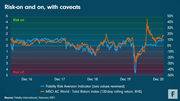
12 Feb 2021
Grafiek Fidelity: Risicobereidheid dicht bij piek
Beste redacteur,
Beleggers zijn duidelijk nog steeds geneigd tot een risk-on positionering, en zitten met een RAI-score van -1,0 zelfs niet ver meer van het risicosentiment van de laatste twee marktpieken (rond -1,3). Dat schrijft Fidelity International bij haar Grafiek van de Week, gebaseerd op haar interne Risk Aversion Indicator (RAI).
Maar tegelijk wijst Fidelity International erop dat de risicobereidheid slechts één indicator is; beleggers moeten ook fundamentele en waarderingsfactoren in aanmerking nemen. Bovendien blijven institutionele beleggers momenteel veel cash aanhouden, wat wijst op enige voorzichtigheid.
En hoewel de gemiddelde waarderingen naar historische maatstaven vrij hoog lijken, zijn ze dat minder in de context van de zeer lage obligatierentes. Ondertussen blijven zowel Fidelity's indicatoren voor macrofundamentals als de bottom-up prognoses voor de winstgroei dit jaar positief.
Hieronder vindt u het volledige bericht:
Chart Room: Risk-on and on, with caveats
Despite some recent pockets of irrational exuberance, most investors remain risk-on. However, caution and careful positioning are important from here, based on the latest readings from Fidelity’s risk aversion indicator.
Global equities have rallied more than 70 per cent from their trough last spring, so you don’t have to look far for signs of froth in markets. The recent GameStop episode highlighted the fragility which exists in pockets of the market, such as popular equity shorts. The same applied to dollar shorts in currencies. Both groups were recently short squeezed.
This week’s Chart Room looks at how, despite the ructions in some corners of the markets, sentiment remains broadly risk-on. But the latest readings from Fidelity International’s proprietary Risk Aversion Indicator (RAI), developed by our Multi Asset team, bear watching.
The RAI is a cross-asset sentimental signal, covering equity, bonds, commodities and foreign exchange. Its inputs include prices, credit spreads and implied volatility data. Aggregating these into a single indicator gives a high-level view of where risk sentiment is relative to history; a score below zero indicates risk-on sentiment, while above zero indicates risk-off.
Currently, the score hovers around -1.0. That suggests investors are clearly biased towards risk-on positioning, but still not to the levels reached during the last two market peaks (which hit readings of around -1.3).
What risk sentiment tells us
While the market rallied aggressively after the correction last year, risk sentiment (viewed through the RAI) was relatively subdued because implied volatility remained elevated. This was particularly true in equities, due to lockdown fears and a lack of participants in short volatility trades. As the chart shows, the result in the second half of 2020 was a visible disconnect between price and volatility-based indicators.
At current levels, the RAI suggests we may not be far from peak market sentiment - but it stops short of telling us just how far. At least for now, we see benefit to remaining risk-on, and specifically long equities. That said, forward-looking returns from these RAI levels have historically been asymmetric to the downside, so it is prudent to be nimble and monitor the signal closely.
But sentiment is just one indicator; investors need to put it into context by considering fundamental and valuation factors, too. Cash allocations remain high among institutional investors, suggesting some caution in their positioning. And while average valuations appear quite high by historical standards, they appear less stretched in the context of record low bond yields. Meanwhile, Fidelity’s indicators of macro fundamentals as well as our bottom-up forecasts for earnings growth this year remain positive. So far as sentiment is a guide, it’s risk-on, and on.
Notes to editors
Voor meer informatie:
Lieke Liefkes, Stampa
fidelity@stampacommunications.com
+31 (0)20 404 2630
This material is provided to you in your capacity as media agency/journalist. The material serves exclusively as background information. Rewriting of content is under your responsibility unless otherwise agreed.


